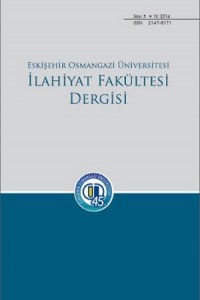An approach to the Mâtürîdî’s Data Sources that he used them in Ta’wîlâtu'l-Qur’ân in the context of Ahkam Verses
Abstract
Imam Abû Mansûr Muhammad al-Mâturîdî is among the most
important jurists (al-fuqahâ) of the Hanafi Sect. At the same time he has deep
knowledge of the science of faith (al-Aqîda) and theology (al-Kalâm); so, he is
considered the Imam of a sect known by his name. Mâturîdî, who has also a very
high order in other Islamic sciences, has a great work named Ta’wîlâtu'l-Qur’ân. He has benefited from a number of data sources in a certain order and
arrangement when he has interpreted the verses in this work that one of the first
and most important representatives of intellectual commentary (al-tafsîr aldirâya).
We can divide these sources into two groups; one of them is internal
(mandatory, essential, primary) and the other is external (essential, subsidiary,
secondary). Exegesis of the Qur’ân with the Qur’ân, the tradition (al-Sunna), the
Arabic language, revelation occasions, the writing and recitation differences
constitute the internal sources. The external resources take place from Arabic
Literature and the eloquence, the view of Companions (al-Sahâba), the ideas of
the next generation (al- Tâbiîn) and the other scholars, the views of the sects, the
customs and the Jewish rumors. These are among the data sources referenced by
many of commentators in the tradition of commentary. The subject of this article
consists of exploring those data sources referred by Mâturîdî.
Mâtürîdî’nin Te’vilâtü’l-Kur’ân’da Kullandığı Veri Kaynaklarına Ahkâm Ayetleri Ekseninde Bir Yaklaşım
Abstract
İmam Ebû Mansûr Muhammed el-Mâtürîdî, Hanefi Mezhebinin en
önemli fakihleri arasında yer alır. Aynı zamanda o, adıyla anılan bir mezhebin
İmamı kabul edilecek kadar Akaid ve Kelam ilimlerine vakıftır. Diğer İslam
ilimlerinde de gayet yüksek bir mertebeye sahip olan Mâtürîdî’nin Te’vîlâtü’lKur’ân
adlı bir tefsiri bulunmaktadır. Dirayet tefsirinin ilk ve önemli
temsilcilerinden olan bu eserinde o, ayetleri açıklarken mesnetsiz hareket
etmemekte, belli bir nizam ve tertip içerisinde birtakım veri kaynaklarından
yararlanmaktadır. Biz bu kaynakları, biri dahili (zorunlu, zaruri, birincil), diğeri
harici (gerekli, tali, ikincil) olmak üzere ikiye ayırabiliriz. Kur’an’ın Kur’anla,
sünnetle, Arap lügatiyle, nüzul sebepleriyle, yazım ve kıraat farklılıklarıyla tefsiri
dahili kaynakları oluşturmaktadır. Harici kaynaklar ise, Arap Edebiyatı ve
Belâgatinden, sahabe kavillerinden, tâbiînin ve diğer ulemanın fikirlerinden,
mezheplerin görüşlerinden, örf ve gelenekten ve İsrâîlî rivayetlerden meydana
gelmektedir. Tefsir geleneğinde bunlar müfessirlerin çoğu tarafından başvurulan
veri kaynakları arasında yer almaktadır. Bu makalenin konusu, Mâtürîdî’nin
atıfta bulunduğu bu veri kaynaklarını ortaya koymaktan ibarettir
Details
| Other ID | JA57HJ85JV |
|---|---|
| Journal Section | Articles |
| Authors | |
| Publication Date | December 30, 2015 |
| Submission Date | March 1, 2016 |
| Published in Issue | Year 2015 Volume: 2 Issue: 3 |
Journal of Eskisehir Osmangazi University Faculty of Theology (ESOGUIFD) is licensed under a Creative Commons Attribution Non-Commercial 4.0 International license.


